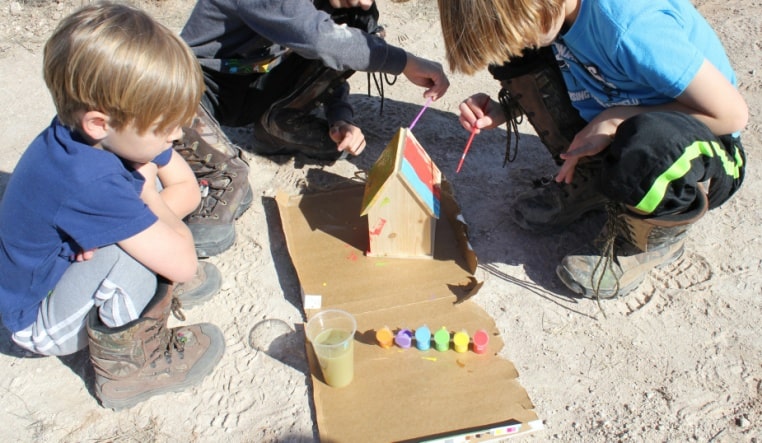The Benefits of Multi-Age Teaching

“I wanna see, too,” said little brother as he gently nudged his big brother away from the microscope.
“Yes, take turns. You can both see,” I reminded them. They each gazed into the microscope with wonder, amazed that a whole tiny world existed that was previously invisible to them. Their big sister had already had her turn and was proudly pointing out things to notice to her brothers.
These were some of my favorite school times together. Watching them all learn as a group. I thought of my own siblings and how we had enjoyed everything more when we were together.
Easier on the Teacher
If you are homeschooling more than one child or if you will be soon, chances are, you’ve thought of teaching them together. Maybe this seems intimidating or you’re afraid someone will get left behind or held back. Well, this doesn’t have to be the case and through the years, I have found many ways to teach subjects to my children of many different ages, all at the same time.
There’s only one of you and the less you have to focus on, the better your focus can be. Teaching multi-age subjects allows me to teach using quality over quantity. I have more time to focus on just one amazing history lesson, or one awesome experiment, rather than three separate lessons.

My first three children were 4, 6, and 8 when we started classes together. They were ALWAYS taught together in history, science, character class, and spelling, and many extra-curricular activities; yup, until graduation.
They have all graduated now and I am teaching my three younger children like this also. The younger two of the first trio were actually taught together in EVERY subject, all the way through school.
Here’s How I Made It Work
First, and foremost, I never want my children comparing themselves to each other.
Although you may be teaching them as one group, they are still individuals with different learning styles and approaches and therefore, different learning speeds. To avoid comparison, I came up with some clever adjustments. I used a permanent marker or tape to cover the grade level of the books we were using. I usually chose books that were somewhere between the oldest and youngest, but still, I covered the grade level. I often used books that were already multi-leveled; like books that said Grades 3-5. I don’t bother doing this with books that already have multi-grades on them.
For history and science, I would read it aloud then we would discuss it and we would do projects or experiments together. For spelling, I always used a curriculum that allowed for the style of teaching I wanted to do. Spelling Power worked well for this. I would read down through the list and each child would spell the words on their paper, or aloud. Even though we chose to do math and grammar separately, there are still lots of ways you can do these together as well. There are lots of math and grammar activities that we did do together like games or creative writing assignments. We also did art, music, nature study, animal study, and reading alouds together.
It’s not one of those all or nothing approaches, tailor it to your own specific needs. If this still seems too daunting, maybe try one subject, just one, and you will see if you like it.

Personally, I have found that a five year age gap is still very doable. More than that may not be, but that very much depends on the children. If my children are three years or less apart in age, I completely ignore that fact and teach them at the same time from books that fall between their grades. This was done with success in one-room schoolhouses for decades and the benefits are extraordinary.
Children can actually learn more this way than when they are taught separately.
It has been my experience that children are not held back by this approach. Quite the opposite is true. They seem to excel even further.
For instance, one will question something that the other will not have thought of while the other may approach things from a totally different angle. It is good for them to be challenged by one another. They feed off of each other’s ideas. One will come up with a plan for a project that the other will be challenged by and stretched and in the end, they will both have learned far more than doing their own books and assignments; even if their own were individualized and tailored to them.
IT IS NOT TEACHER-INTENSIVE
Some shy away from multi-age teaching because they fear it will be teacher-intensive. Again, this does not have to be the case.
Children can be taught together from a self-taught curriculum. They can still do the lessons together even without your input. Reading and discussing a lesson, just the two of them, is one of my boys’ favorite ways to do school. Sometimes, they even write one paper together about the lesson or do a mutual project about it. They enjoy movies or doing apps together, too. This kind of learning creates an atmosphere of togetherness and a special bond that carries beyond the classroom and overflows into all of life.
You will find your children spending more time together and getting along better as they have achieved something together that they both take pride in. I have often found my boys still working on a school project, especially science projects and experiments, not even realizing that the expected school time has long passed.
Multi-age teaching can be a huge benefit to your children and to you. The years of memories that they will have spending all of those times together will be well worth it. It is a unique and unforgettable experience that my grown kids still talk and laugh about to this very day.







The great thing with homeschooling is you can structure it however you feel is best! My 5 year old joins us when he chooses, we aren't formally doing any school with him yet (but he knows the different types of blood cells & the differences between a turtle & a tortoise ). I regret giving in to social pressure & starting my first 2 on "school" too young.
That's so true, Tina. That's what we do with my four-year-old, too, and it really does work. They learn so much. You know what's best and you know your child. Every child is different and it's great that you are following your own instincts. Your child is lucky to have a great mom like you.
I have always grouped our three children together for as much work as possible. My oldest son will be starting highschool next year, and I have had doubts about continuing on this way. It is nice to hear that you successfully continued this method all the way through graduation.